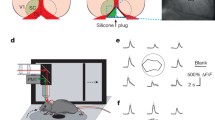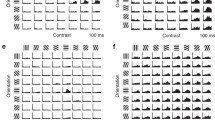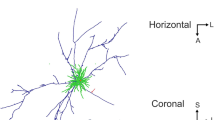Summary
Receptive field (RF) characteristics of cells in primary visual cortex of the mouse (C57B16 strain) were studied by single unit recording. We have studied the functional organization of area 17 along both the radial and tangential dimensions of the cortex. Eighty seven percent of the visual neurons could be classified according to their responses to oriented stimuli and to moving stimuli. Cells which preferred a flashed or moving bar of a particular orientation and responded less well to bars of other orientations or to spots, were classified as orientation selective (simple RF 23%, complex RF 18%). The majority of them were, moreover, unidirectional (24%). All orientations were roughly equally represented. Cells with oriented RFs were recorded mostly in the upper part of cortical layers II–III, where they appeared to be clustered according to their preferred orientation. Neurons that responded equally well to spots and bars of all orientations (46%) were classified as “non-oriented”; among these neurons there were several subcategories. Cells which responded equally well to spots and bars but preferred stimuli moving along one or both directions of a particular axis were classified as non oriented asymmetric cells (unidirectional 14%, bidirectional 4%). They were recorded mainly in supra- and infra-granular layers. Cells unaffected by stimulus shape and orientation which responded equally well to all directions of movement were classified as symmetric units. They had receptive field classified as ON (11%), OFF (1%), ON/ OFF (11%), or were unresponsive to stationary stimuli (5%). These cells were mostly found in layer IV, in which they constituted the majority of recorded cells. There was no apparent correlation between the functional type and size of RFs. However, the greatest proportion of small RFs was found in layer IV. In the binocular segment of the mouse striate cortex, the influence of the contralateral eye predominated. Ninety five percent of cells in this segment were driven through the contralateral eye. However, 70% of cells were binocularly activated, showing that considerable binocular integration occured in this cortical segment. Ocular dominance varied less along the radial than along the tangential dimension of the cortex.
Similar content being viewed by others
References
Bishop PO, Burke W, Davis R (1962) The identification of single units in central visual pathway. J Physiol 162: 409–431
Bousfield JD (1977) Columnar organization and the visual cortex of the hamster. Brain Res 136: 154–158
Burne RA, Parnavelas JG, Lin CS (1984) Responses properties of neurons in the visual cortex of the rat. Exp Brain Res 53: 374–383
Caviness VS (1975) Architectonic maps of neocortex of the normal mouse. J Comp Neurol 164: 247–264
Caviness VS, Frost DO (1983) Thalamocortical projections in the reeler mutant mouse. J Comp Neurol 219: 182–202
Chapin JK (1986) Laminar differences in sizes, shapes, and responses profiles of cutaneous receptive fields in the rat SI cortex. Exp Brain Res 62: 549–559
Chow KL, Masland RH, Stewart DL (1971) Receptive field characteristics of striate cortical neurons in the rabbit. Brain Res 33: 337–352
Diao YC, Wang YK, Pu ML (1983) Binocular responses of cortical cells and the callosal projection in the albino rat. Exp Brain Res 49: 410–418
Dräger UC (1974) Autoradiography of tritiated proline and fucose transported transneuronally from the eye to the visual cortex in pigmented and albino mice. Brain Res 82: 284–292
Dräger UC (1975) Receptive fields of single cells and topography in mouse visual cortex. J Comp Neurol 160: 269–287
Dräger UC (1981) Observations on the organization of the visual cortex in the reeler mouse. J Comp Neurol 201: 555–570
Frost DO (1982) Anomalous visual connections to somatosensory and auditory systems following brains lesions in early life. Dev Brain Res 3: 627–635
Frost DO, Caviness VS (1980) Radial organization of thalamic projections to the neocortex in the mouse. J Comp Neurol 194: 369–394
Frost DO, Edwars MA, Sachs GM, Caviness VS (1986) Retinotectal projection in reeler mutant mice; relationships among axon trajectories, arborization patterns and cytoarchitecture. Dev Brain Res 28: 109–120
Frost DO, Métin C (1985) Induction of functional retinal projection to the somatosensory system. Nature 317(6033): 162–164
Godement P (1984) Development of retinal projections in the mouse. In: Stone J, Dreher B, Papaport DH (eds) Development of visual pathways in mammals. Neurology and neurobiology, Vol 9. Alan R Liss, New York, pp 127–143
Godement P, Saillour P, Imbert M (1979) Thalamic afferents to the visual cortex in congenitally anophthalmic mice. Neurosci Lett 13: 271–278
Godement P, Saläun J, Métin C (1987) Fate of uncrossed retinal projections following early or late prenatal monocular enucleation in the mouse. J Comp Neurol 255: 97–109
Henry GH (1977) Receptive field classes of cells in the striate cortex of the cat. Brain Res 133: 1–28
Henry GH, Bishop PO, Dreher B (1974a) Orientation axis and direction as stimulus parameter for striate cells. Vision Res 14: 767–779
Henry GH, Dreher B, Bishop PO (1974b) Orientation specificity of cells in the cat striate cortex. J Neurophysiol 37: 1394–1409
Hubel DH, Wiesel TN (1962) Receptive fields binocular interaction and functional architecture in the cat's visual cortex. J Physiol Lond 160: 106–154
Hubel DH, Wiesel TN (1968) Receptive fields and functional architecture of monkey striate cortex. J Physiol Lond 195: 215–243
Hughes A (1977) The topography of vision in mammals of contrasting life style: comparative optics and retinal organization. In: Crescitelli F (ed) The visual system in vertebrates. Handbook of sensory physiology, Vol VII. Springer, Berlin Heidelberg New York, pp 613–756
Hughes A (1980) Directional units in the rat optic nerve. Brain Res 202: 196–200
Kaiserman-Abramof I, Graybiel A, Nauta W (1980) The thalamic projection to cortical area 17 in congenitally anophthalmic mouse strain. Neuroscience 5: 41–52
Kato H, Bishop PO, Orban GA (1978) Hypercomplex and simple/ complex classification in cat. J Neurophysiol 41: 1071–1095
Lemmon V, Pearlman AL (1981) Does laminar position determine the receptive field properties of cortical neurons? A study of corticotectal cells in area 17 of normal mouse and the reeler mutant. J Neurosci 1: 83–93
Leventhal AG, Hirsch HVB (1978) Receptive field properties of different classes of neurons in visual cortex of normal and dark-reared cats. J Neurophysiol 43: 1111–1132
Levick WR, Thibos LN (1980) Orientation bias of cat retinal ganglion cells. Nature 286: 389–390
Mangini NJ, Pearlman AL (1980) Laminar distribution of receptive field properties in the primary visual cortex of the mouse. J Comp Neurol 193: 203–222
Métin C (1984) Organisation anatomo-fonctionelle du système rétino géniculo cortical chez la souris. Thèse de 3ème cycle en Sciences naturelles, mention neurophysiologie. Université Pierre et Marie Curie, Paris
Montero VM (1981) Comparative studies on the visual cortex. In: Woolsey CN (ed) Multiple visual areas. Cortical sensory organization, Vol II. The Humana Press, pp 33–81
Montero VM, Brugge JS (1969) Direction of movement as the significant parameter stimulus for some lateral geniculate cells in the rat. Vision Res 9: 71–88
Murphy EH, Berman N (1979) The rabbit and the cat. A comparison of some features of response properties of single cells in the primary cortex. J Comp Neurol 188: 401–428
Oyster CW, Barlow HB (1967) Direction selective units in rabbit retina: distribution of prefered directions. Science 155: 841–842
Peters A, Proskauer CC, Feldman ML, Kimerer L (1979) The projection of the lateral geniculate nucleus to area 17 of the rat cerebral cortex. V. Degenerating axon terminals synapsing with Golgi impregnated neurons. J Neurocytol 8: 331–357
Remtulla S, Hallett PE (1985) A schematic eye for the mouse, and comparisons with the rat. Vision Res 25: 21–31
Schall JD, Vitek DJ, Leventhal AG (1986) Retinal constraints on orientation specificity in cat visual cortex. J Neurosci 6: 823–836
Shaw C, Yinow U, Auerbach E (1975) Receptive fields and response properties of neurons in the rat visual cortex. Vision Res 15: 203–208
Simmons PA, Lemmon V, Pearlman AL (1982) Afferent and efferent connections of the striate and extrastriate visual cortex of the normal and reeler mouse. J Comp Neurol 211: 295–308
Simmons PA, Pearlman AL (1982) Retinotopic organization of the striate cortex (area 17) in the reeler mutant mouse. Dev Brain Res 4: 124–126
Simmons PA, Pearlman AL (1983) Receptive field properties of transcallosal visual cortical neurons in the normal and reeler mouse. J Neurophysiol 50: 838–848
Stewart DL, Chow KL, Masland RH (1971) Receptive field characteristics of lateral geniculate neurons in the rabbit. J Neurophysiol 34: 139–147
Tiao YC, Blakemore C (1976b) Functional organization in the visual cortex of the golden hamster. J Comp Neurol 168: 459–482
Vidyasagar TR, Urbas JV (1982) Orientation sensitivity of cat LGN neurons with and without inputs from visual cortical areas 17 and 18. Exp Brain Res 46: 157–169
Wagor E, Mangini NJ, Pearlman AL (1980) Retinotopic organization of striate and extrastriate visual cortex in the mouse. J Comp Neurol 193: 187–202
White EL (1979) Thalamo-cortical synaptic relations: a review with emphasis on the projections of specific thalamic nuclei to the primary sensory areas of the neocortex. Brain Res Rev 1: 275–312
Wiesenfield Z, Kornel EE (1975) Receptive fields of simple cells in the visual cortex of the hooded rat. Brain Res 94: 401–412
Yorke CM, Caviness VS (1975) Interhemispheric neocortical connections of the corpus callosum in the normal mouse: a study based on anterograde and retrograde methods. J Comp Neurol 164: 233–243
Author information
Authors and Affiliations
Rights and permissions
About this article
Cite this article
Métin, C., Godement, P. & Imbert, M. The primary visual cortex in the mouse: Receptive field properties and functional organization. Exp Brain Res 69, 594–612 (1988). https://doi.org/10.1007/BF00247312
Received:
Accepted:
Issue Date:
DOI: https://doi.org/10.1007/BF00247312




